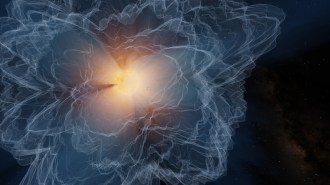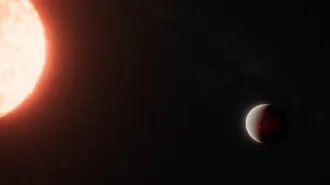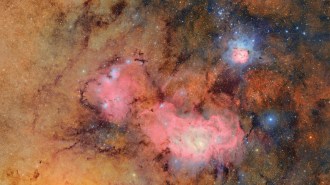For all the hand wringing among physicists about the nature of dark energy, the invisible stuff that appears to be revving up the rate of cosmic expansion, a nagging possibility remains. Dark energy could be a cosmic mirage — if humans live in a special place in the universe with a peculiar distribution of matter.

If Earth and its environs are centered in a vast, billion-light-year-long bubble, relatively free of matter, in turn surrounded by a massive, dense shell of material, then gravity’s tug would cause galaxies inside the void to hurtle toward the spherical concentration of mass, say theorists Robert Caldwell of Dartmouth College and Albert Stebbins of the Fermi National Accelerator Laboratory in Batavia, Ill. That process would mimic the action of dark energy — a local observer would be tricked into thinking that the universe’s expansion is accelerating.
But that scenario violates the Copernican principle, a notion near and dear to the hearts of physicists and cosmologists, including Caldwell and Stebbins. Named after the 16th century astronomer Nicolaus Copernicus, who made the then heretical proposal that Earth does not have a favored, central position in the solar system, the principle states that humans are not privileged observers in the universe, but have just as good — or bad — a vantage point as any other observer in the cosmos.
“Although the Copernican principle may be widely accepted by fiat, it is imperative that such a foundational principle be proven,” Caldwell and Stebbins assert in the May 16 Physical Review Letters. The researchers suggest a concrete way to check once and for all whether our neck of the cosmic woods is different from other parts of the universe. Their test relies on observations of the cosmic microwave background, the leftover radiation from the Big Bang that bathes all parts of the universe.
If Earthlings did reside at the center of a vast bubble, the spectrum of radiation from the microwave background that came directly to Earth — without reflection — would trace a curve characteristic of blackbody radiation. That’s the spectrum of light emitted by a perfect blackbody of a particular temperature, in this case 2.7 kelvins.
But now consider the viewpoint of another observer, not centered on the bubble. That observer would look out and see an asymmetric universe, with a matter-free region — the bubble — off to one side and a higher density distribution of matter everyplace else. This lopsided distribution of matter would leave its imprint on the microwave background. The photons would have a variety of different energies, depending on whether they originated in a high or low density region, and the resulting spectrum would no longer look like a blackbody’s.
Two observers, two separate views of the universe, and never the twain shall meet. Except that the two views are not separate, Caldwell and Stebbins calculate. Electrons floating through the universe, stripped from atoms, act like tiny mirrors, reflecting some of the microwave background photons seen by other observers back toward Earth. So if humans live in a special place in the universe, they ought to know it because the microwave background will contain tiny deviations from a perfect blackbody spectrum.
Those deviations would be too small to have been detected in the spectrum of the microwave background recorded in the early 1990s by NASA’s Cosmic Background Explorer, which remains the most precise measurement of that spectrum. But a newly proposed NASA satellite, the Absolute Spectrum Polarimeter, could easily detect such deviations, says Alan Kogut of NASA’s GoddardSpaceFlightCenter in Greenbelt, Md. The mission could be launched next decade.
In another upcoming Physical Review Letters, Jean-Philippe Uzan of Pierre and MarieCurieUniversity in Paris, along with Chris Clarkson and George Ellis of the University of Cape Town in Rondebosch, South Africa, suggest a different way to test the Copernican principle. They note that over time, as dark energy speeds up cosmic acceleration, the recession velocities of galaxies would change, as indicated by a change in their redshift — the shift in wavelength of light to redder, or longer wavelengths, due to a speedup.
By measuring both redshifts and distances to remote galaxies over a 10-year span, the researchers say that astronomers should be able to tell whether we live in a Copernican universe.
In a cosmos that is the same everywhere, “the expansion rate of the universe at distant objects and the distances we measure to those objects have to be related in a very precise way,” notes Clarkson. That’s not the case in a universe with a special location.
“At the moment the drift can’t be measured at all, so very large telescopes are needed together with very sensitive spectrographs,” Clarkson says. “It’s an extremely small effect.”
Caldwell says that “mathematically they may be justified, but the necessary precision and accuracy may not be achievable for many years.”
Whichever test pans out first, Caldwell is hoping that Earth’s corner of the universe is just like everywhere else. Then he can get back to worrying full time about his favorite topic, dark energy.
Now isn’t that special?







